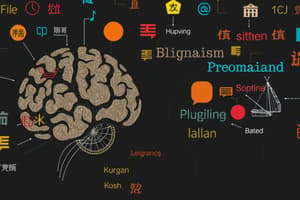Podcast
Questions and Answers
Bilingual individuals show increased gray matter density in areas associated with language and executive function.
Bilingual individuals show increased gray matter density in areas associated with language and executive function.
True (A)
Broca's Area is primarily responsible for enhancing language comprehension in bilinguals.
Broca's Area is primarily responsible for enhancing language comprehension in bilinguals.
False (B)
The connectivity between brain regions in bilinguals is believed to facilitate efficient language inhibition.
The connectivity between brain regions in bilinguals is believed to facilitate efficient language inhibition.
True (A)
Monolingual individuals have a higher density of gray matter in the prefrontal cortex compared to bilingual individuals.
Monolingual individuals have a higher density of gray matter in the prefrontal cortex compared to bilingual individuals.
The Angular Gyrus is involved in processing meaning and play a role in bilingual reading and writing.
The Angular Gyrus is involved in processing meaning and play a role in bilingual reading and writing.
The Anterior Cingulate Cortex helps in language switching and is less active in bilinguals compared to monolinguals.
The Anterior Cingulate Cortex helps in language switching and is less active in bilinguals compared to monolinguals.
Regularly using two languages can enhance connectivity in the executive control network in bilinguals.
Regularly using two languages can enhance connectivity in the executive control network in bilinguals.
Bilingual brains primarily rely on Broca's Area to manage two languages.
Bilingual brains primarily rely on Broca's Area to manage two languages.
The hippocampus is linked to language selection.
The hippocampus is linked to language selection.
Bilingual individuals have a more developed caudate nucleus than monolinguals.
Bilingual individuals have a more developed caudate nucleus than monolinguals.
Bilingualism has no impact on brain structure.
Bilingualism has no impact on brain structure.
Understanding neuroplasticity can encourage TEFL teachers to use storytelling.
Understanding neuroplasticity can encourage TEFL teachers to use storytelling.
Bilinguals do not benefit from metalinguistic awareness.
Bilinguals do not benefit from metalinguistic awareness.
Bilinguals often need to inhibit one language while using another.
Bilinguals often need to inhibit one language while using another.
TEFL classrooms should ignore brain differences between bilingual and monolingual learners.
TEFL classrooms should ignore brain differences between bilingual and monolingual learners.
The executive function of bilinguals is typically less developed than that of monolinguals.
The executive function of bilinguals is typically less developed than that of monolinguals.
Bilingual individuals rely more on the prefrontal cortex for managing language tasks than monolinguals.
Bilingual individuals rely more on the prefrontal cortex for managing language tasks than monolinguals.
The bilingual brain shows less neuroplasticity compared to the monolingual brain.
The bilingual brain shows less neuroplasticity compared to the monolingual brain.
Bilinguals have a reduced capacity for multitasking compared to monolinguals.
Bilinguals have a reduced capacity for multitasking compared to monolinguals.
Managing two languages leads to superior cognitive flexibility in bilinguals.
Managing two languages leads to superior cognitive flexibility in bilinguals.
Bilingualism can alter the brain's structure over time.
Bilingualism can alter the brain's structure over time.
Bilingual individuals have a lower metalinguistic awareness than monolinguals.
Bilingual individuals have a lower metalinguistic awareness than monolinguals.
The basal ganglia are involved in language management for bilinguals.
The basal ganglia are involved in language management for bilinguals.
Bilingual individuals struggle more with complex problem-solving than monolinguals.
Bilingual individuals struggle more with complex problem-solving than monolinguals.
Flashcards
Broca's Area
Broca's Area
A brain region in the left frontal lobe involved in speech production and grammar processing.
Wernicke's Area
Wernicke's Area
A brain region in the left temporal lobe responsible for language comprehension.
Prefrontal Cortex
Prefrontal Cortex
Plays a central role in executive functions like working memory, attention, and inhibition, especially in bilingual brains needing to switch between languages.
Bilingual Brain Connectivity
Bilingual Brain Connectivity
Signup and view all the flashcards
Executive Functions
Executive Functions
Signup and view all the flashcards
Gray Matter Density
Gray Matter Density
Signup and view all the flashcards
Language Switching
Language Switching
Signup and view all the flashcards
Bilingual Executive Control
Bilingual Executive Control
Signup and view all the flashcards
Bilinguals' language management
Bilinguals' language management
Signup and view all the flashcards
Metalinguistic awareness in bilinguals
Metalinguistic awareness in bilinguals
Signup and view all the flashcards
Cognitive flexibility in bilinguals
Cognitive flexibility in bilinguals
Signup and view all the flashcards
Bilinguals' working memory
Bilinguals' working memory
Signup and view all the flashcards
Neuroplasticity in bilingual brains
Neuroplasticity in bilingual brains
Signup and view all the flashcards
Monolinguals' language processing
Monolinguals' language processing
Signup and view all the flashcards
Bilingualism and learning new languages
Bilingualism and learning new languages
Signup and view all the flashcards
TEFL and bilingual students
TEFL and bilingual students
Signup and view all the flashcards
Bilingual Brain Development
Bilingual Brain Development
Signup and view all the flashcards
Neuroplasticity in Bilinguals
Neuroplasticity in Bilinguals
Signup and view all the flashcards
Language Control Exercises
Language Control Exercises
Signup and view all the flashcards
Cognitive Control
Cognitive Control
Signup and view all the flashcards
Metalinguistic Awareness
Metalinguistic Awareness
Signup and view all the flashcards
Comparison Activities
Comparison Activities
Signup and view all the flashcards
Bilingual Advantages in TEFL
Bilingual Advantages in TEFL
Signup and view all the flashcards
TEFL strategies for bilinguals
TEFL strategies for bilinguals
Signup and view all the flashcards
Study Notes
Bilingualism and the Brain
- Bilingualism affects how the brain processes language.
- Different brain regions are involved in language processing, including Broca's Area (speech production), Wernicke's Area (comprehension), Angular Gyrus (reading/writing), Prefrontal Cortex (executive functions), Basal Ganglia and Anterior Cingulate Cortex (language switching).
- Bilinguals show increased connectivity between these brain regions, especially in areas related to executive function (control and inhibition).
- Bilingualism increases grey matter density in language and executive function areas (especially prefrontal cortex and anterior cingulate cortex).
- Bilinguals exhibit enhanced cognitive flexibility and working memory compared to monolinguals.
- This enhanced control and flexibility can aid in multitasking and complex problem-solving.
- Bilinguals have higher metalinguistic awareness, understanding how language works.
- Bilingualism promotes neuroplasticity, leading to adaptations in the brain's structure and function (more developed hippocampus and caudate nucleus).
- The primary difference between monolingual and bilingual brains is how the executive control network manages language. Monolinguals don't need to switch languages, whereas bilinguals actively engage in code-switching.
- Bilingual brains show a heightened awareness of language rules and structures (metalinguistic awareness).
Practical Applications in TEFL
- Teachers can utilize activities that leverage the strengths of bilingual students (e.g., tasks needing attention shifts or controlled inhibition).
- Compare word meanings or grammatical structures between languages.
- Incorporate activities that work with working memory and cognitive flexibility, encouraging bilingual students to strengthen these areas.
- Long-term projects (e.g., storytelling, journaling) are beneficial for reinforcing language connections (neuroplasticity).
- Language control exercises (switching between different language registers, e.g., formal and informal English) can mimic the cognitive process bilinguals use in managing multiple languages.
- Activities can focus on identifying similarities and differences between the student's native language and English to utilize metalinguistic awareness.
Studying That Suits You
Use AI to generate personalized quizzes and flashcards to suit your learning preferences.




